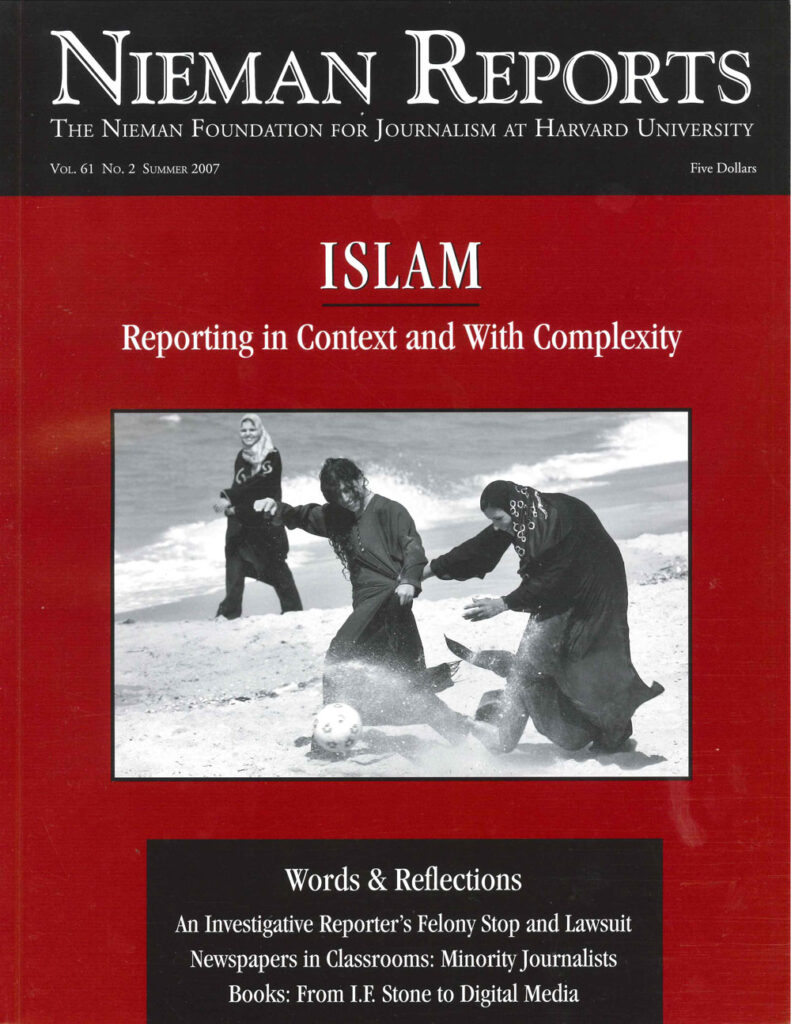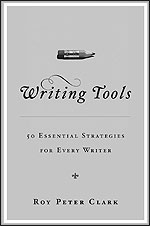Most writing guides suffer the same fate as books about comedy: These earnest primers undermine their message by lacking the very quality they aspire to teach. That's why Roy Peter Clark's "Writing Tools: 50 Essential Strategies for Every Writer" establishes itself as an essential writing resource. Exemplary might be the best word to describe this terrific guide, for not only does Clark produce a new standard of excellence, but he does so by drawing from a rich and vivid collection of writing samples that teach by example.
Clark addresses the craft of writing with a hands-on, nitty-gritty approach to improvement. Rather than offer overarching theories about writing, he grounds the reader in practical improvement by presenting 50 sharp, focused "tools." More than simple rules of grammar and syntax, each of the 50 insights he shares with us carries the weight of experience. They are sharp, refined and build on conventional wisdom.
Consider, for example, tool (and therefore chapter) 4, "Be passive-aggressive." Clark doesn't simply repeat the old saw to always avoid the passive voice. "My point is that you can create acceptable prose, from time to time, without any active verbs," he says. He cites a great passage from Steinbeck in which the master mixes a dozen active verbs with one well-placed passive verb that describes the action precisely. Why does it work here? In this well-chosen passage, the writer has selected the passive verb "to call attention to the receiver of the action." Clark then strengthens this insight with several other surprising yet no-less-forceful passages.
Or savor Clark's sage counsel to "let punctuation control pace and space." There's a wealth of guides that teach you how to cross your "t's" and differentiate between an "n" dash and an "em" dash; "Writing Tools" provides more nuanced wisdom on using the appropriate comma, colon, semicolon or dash for dramatic effect.
Throughout the guide Clark sprinkles simple gems of common sense: "Donald Murray taught me that brevity comes from selection, not compression, a RELATED WEB LINK
"Fifty Writing Tools: Quick List"
– poynter.orglesson that requires lifting blocks from the work." Or "Remember that clear prose is not just a product of sentence length and word choice. It derives first from a sense of purpose—a determination to inform."
And, refreshingly, in a quiet manner that is neither under- nor overstated, Clark practices what he preaches. To wit: Chapter 37, titled, "In short works, don't waste a syllable," opens with this passage:
"I've seen the Hope Diamond at the Smithsonian. At forty-five carats, it is big and blue and buxom, but not beautiful. Smaller gems have more facets and reflect light with more brilliance. The same can be true of writing."
Clark backs up all his tools with superb selections from David Sedaris, Tom RELATED ARTICLE
"A Sampling of Clark's 50 Writing Tools"
– Tom EhrenfeldWolfe, Anna Quindlen, Nora Ephron, and scores of other talented journalists and authors. He blends his examples with the lessons seamlessly, teaching with the perfect recipe of content and context. In fact, some of the examples are so apt that one can't help but wonder whether Clark has found them to be great proof of his principles—or simply reverse-engineered the tools from his favorite passages of writing. With the "Set the pace with sentence length" chapter, for example, he illustrates with a perfectly paced passage from Laura Hillenbrand's "Seabiscuit" that canters when need be and trots when essential.
Clark also culls terrific examples from the work of newspaper journalists who demonstrate that great writing can be found anywhere. This expansive approach to writing excellence bolsters another crucial lesson, Tool 43's "Read for both form and content." While great teachers can help writers improve their skills, Clark reminds us that "smart writers continue to learn, by reading work they admire again and again 'to see how it works.'"
I'll close with a big fat excerpt from the introduction. Check out Clark's encouraging words, which in their clear and powerful language present the promise of this book. Writing is not a rarified art reserved for a privileged few, Clark argues, but a craft that can be learned by anyone with patience, diligence and the guidance of great teachers (including the lessons of "Writing Tools"). Here he exhorts everyone to see themselves as writers.
"If you feel left behind, this book invites you to imagine the act of writing less as a special talent and more as a purposeful craft. Think of writing as carpentry, and consider this book your toolbox. You can borrow a writing tool at any time, and here's another secret: Unlike hammers, chisels and rakes, writing tools never have to be returned. They can be cleaned, sharpened and passed along.
"These practical tools will help to dispel your writing inhibitions, making the craft central to the way you see the world. As you add tools to your workbench, you'll begin to see the world as a storehouse of writing ideas. As you gain proficiency with each tool, and then fluency, the act of writing will make you a better student, a better worker, a better friend, a better citizen, a better parent, a better teacher, a better person."
Tom Ehrenfeld is a freelance journalist based in Cambridge, Massachusetts. Formerly a writer and editor with Inc. Magazine and Harvard Business Review, he is the author of "The Startup Garden: How Growing a Business Grows You." The Poynter Institute (www.poynter.org) is publishing a new version of "Writing Tools: The Blog" to be updated every Monday and Wednesday, with newsletters sent out the following morning with a focus on strategies for improving writing.
Clark addresses the craft of writing with a hands-on, nitty-gritty approach to improvement. Rather than offer overarching theories about writing, he grounds the reader in practical improvement by presenting 50 sharp, focused "tools." More than simple rules of grammar and syntax, each of the 50 insights he shares with us carries the weight of experience. They are sharp, refined and build on conventional wisdom.
Consider, for example, tool (and therefore chapter) 4, "Be passive-aggressive." Clark doesn't simply repeat the old saw to always avoid the passive voice. "My point is that you can create acceptable prose, from time to time, without any active verbs," he says. He cites a great passage from Steinbeck in which the master mixes a dozen active verbs with one well-placed passive verb that describes the action precisely. Why does it work here? In this well-chosen passage, the writer has selected the passive verb "to call attention to the receiver of the action." Clark then strengthens this insight with several other surprising yet no-less-forceful passages.
Or savor Clark's sage counsel to "let punctuation control pace and space." There's a wealth of guides that teach you how to cross your "t's" and differentiate between an "n" dash and an "em" dash; "Writing Tools" provides more nuanced wisdom on using the appropriate comma, colon, semicolon or dash for dramatic effect.
Throughout the guide Clark sprinkles simple gems of common sense: "Donald Murray taught me that brevity comes from selection, not compression, a RELATED WEB LINK
"Fifty Writing Tools: Quick List"
– poynter.orglesson that requires lifting blocks from the work." Or "Remember that clear prose is not just a product of sentence length and word choice. It derives first from a sense of purpose—a determination to inform."
And, refreshingly, in a quiet manner that is neither under- nor overstated, Clark practices what he preaches. To wit: Chapter 37, titled, "In short works, don't waste a syllable," opens with this passage:
"I've seen the Hope Diamond at the Smithsonian. At forty-five carats, it is big and blue and buxom, but not beautiful. Smaller gems have more facets and reflect light with more brilliance. The same can be true of writing."
Clark backs up all his tools with superb selections from David Sedaris, Tom RELATED ARTICLE
"A Sampling of Clark's 50 Writing Tools"
– Tom EhrenfeldWolfe, Anna Quindlen, Nora Ephron, and scores of other talented journalists and authors. He blends his examples with the lessons seamlessly, teaching with the perfect recipe of content and context. In fact, some of the examples are so apt that one can't help but wonder whether Clark has found them to be great proof of his principles—or simply reverse-engineered the tools from his favorite passages of writing. With the "Set the pace with sentence length" chapter, for example, he illustrates with a perfectly paced passage from Laura Hillenbrand's "Seabiscuit" that canters when need be and trots when essential.
Clark also culls terrific examples from the work of newspaper journalists who demonstrate that great writing can be found anywhere. This expansive approach to writing excellence bolsters another crucial lesson, Tool 43's "Read for both form and content." While great teachers can help writers improve their skills, Clark reminds us that "smart writers continue to learn, by reading work they admire again and again 'to see how it works.'"
I'll close with a big fat excerpt from the introduction. Check out Clark's encouraging words, which in their clear and powerful language present the promise of this book. Writing is not a rarified art reserved for a privileged few, Clark argues, but a craft that can be learned by anyone with patience, diligence and the guidance of great teachers (including the lessons of "Writing Tools"). Here he exhorts everyone to see themselves as writers.
"If you feel left behind, this book invites you to imagine the act of writing less as a special talent and more as a purposeful craft. Think of writing as carpentry, and consider this book your toolbox. You can borrow a writing tool at any time, and here's another secret: Unlike hammers, chisels and rakes, writing tools never have to be returned. They can be cleaned, sharpened and passed along.
"These practical tools will help to dispel your writing inhibitions, making the craft central to the way you see the world. As you add tools to your workbench, you'll begin to see the world as a storehouse of writing ideas. As you gain proficiency with each tool, and then fluency, the act of writing will make you a better student, a better worker, a better friend, a better citizen, a better parent, a better teacher, a better person."
Tom Ehrenfeld is a freelance journalist based in Cambridge, Massachusetts. Formerly a writer and editor with Inc. Magazine and Harvard Business Review, he is the author of "The Startup Garden: How Growing a Business Grows You." The Poynter Institute (www.poynter.org) is publishing a new version of "Writing Tools: The Blog" to be updated every Monday and Wednesday, with newsletters sent out the following morning with a focus on strategies for improving writing.




